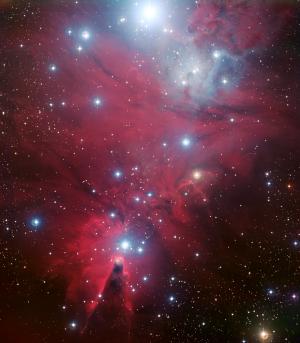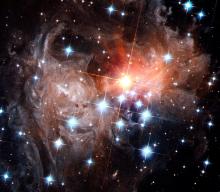Vast clouds of gas and dust have given birth to more than a thousand stars in NGC 2264, a stellar nursery about 2,600 light-years away in the faint constellation Monoceros, the unicorn. The hottest, brightest stars form a cluster known as the Christmas Tree (they form the shape of a tree when viewed upside down, as through the eyepiece of a telescope). Starbirth has now moved south of the cluster and is concentrated near the top of the Cone Nebula, the dark cone at the bottom of the image. [ESO]
You are here
More Monoceros
A wave of starbirth has rolled across a massive cloud of gas and dust in Monoceros, the unicorn. It started a few million years ago, and has given rise to more than a thousand stars. And the process is continuing even now.
The complex is NGC 2264. It consists of two main components. One is a cluster of bright young stars known as the Christmas Tree. And the top of the tree intersects a pillar of dark dust known as the Cone Nebula.
A recent study of the region found that its first stars probably formed about five million years ago, in the northern part of the Christmas Tree. They’re clustered around a brilliant star that has blown away much of the remaining gas and dust. Without that supply of raw materials, fewer stars are being born in that area.
Instead, star formation has moved southward, to the peak of the Cone Nebula. Most of the stars in that area are only about a million years old. They’re still embedded in dense clouds of gas and dust. Many of them are still pulling in some of that material, so they’re still getting bigger. They’re surrounded by wide, flat disks of gas and dust that spiral toward the stars.
These dense “cores” of star formation are surrounded by a “halo” of slightly older stars, which are beginning to move away from their birthplace.
NGC 2264 is in the southeast at nightfall. It’s between the bright stars Procyon and Betelgeuse. But you need a telescope to spot this busy stellar nursery.
Script by Damond Benningfield
Get Premium Audio
Listen to today's episode of StarDate on the web the same day it airs in high-quality streaming audio without any extra ads or announcements. Choose a $8 one-month pass, or listen every day for a year for just $30.





